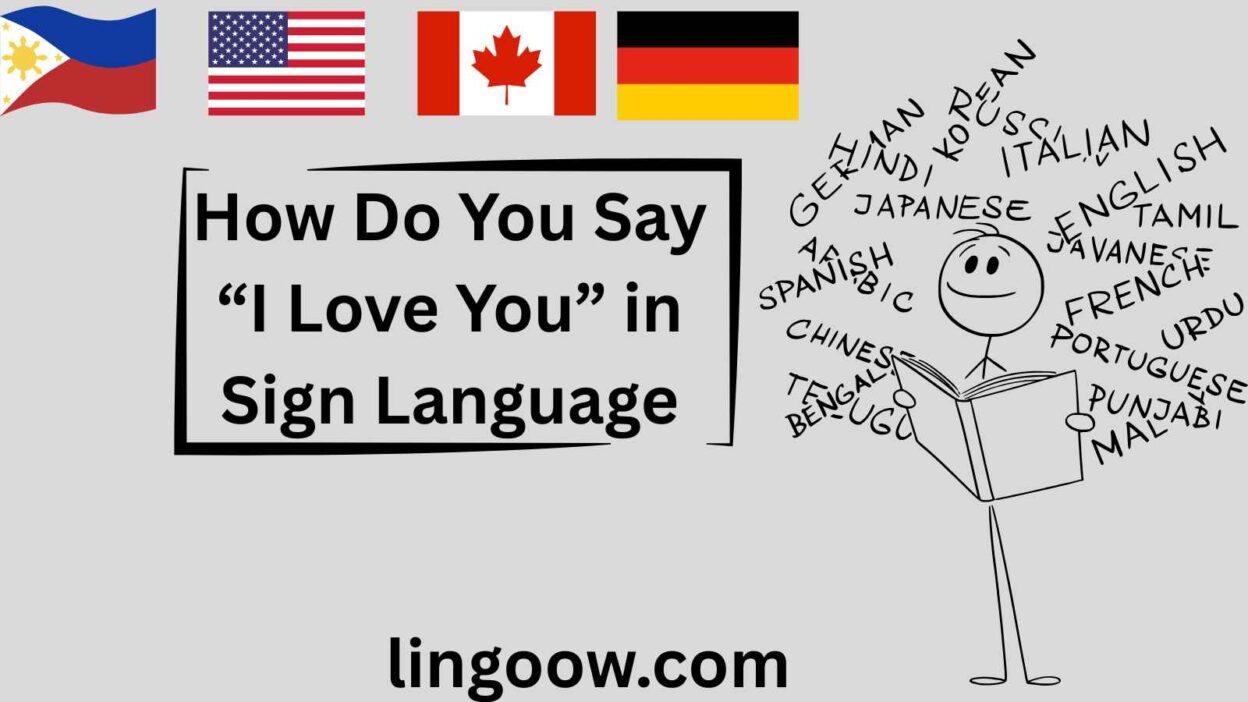Love is a language that transcends words, borders, and cultures. Yet, when spoken through sign language, it takes on a visual poetry that words alone can’t capture. “I love you” — three simple words — can light up hearts, bridge silence, and connect souls across the world. But how do you say I love you when words aren’t spoken at all?
Let’s explore how this universal phrase is expressed in sign language and across different languages and cultures, discovering the shared heartbeat that unites humanity.
💞 Introduction: The Silent Power of Love
Imagine standing across from someone you love — maybe your child, your partner, or your best friend — but you can’t use your voice. You raise your hand, extend your thumb, index, and pinky finger, and gently turn your palm outward.
That simple motion means “I love you” in American Sign Language (ASL). No sound. No words. Just pure feeling.
The beauty of love is that it finds a way to be expressed, even without sound or text. Across cultures and languages — from the romantic rhythm of French to the graceful gestures of Japanese Sign Language — “I love you” remains a universal declaration of connection.
🤟 The Universal Sign for “I Love You”
In American Sign Language (ASL), “I love you” is a combination of three handshapes:
- The letter I (pinky finger up)
- The letter L (thumb and index finger out)
- The letter Y (thumb and pinky out)
When combined, these gestures form the iconic 🤟 symbol — representing “I Love You.”
In other sign languages, such as British Sign Language (BSL) or Japanese Sign Language (JSL), the gestures differ slightly but share the same emotional core: expressing love through movement and connection.
🌍 “I Love You” in Different Spoken Languages
Here’s a look at how people around the world express love — each phrase carrying its own melody, warmth, and cultural meaning.
| Language | Phrase for “I Love You” | Cultural Insight |
|---|---|---|
| English | I love you | Used in daily life and deeply personal moments alike. |
| French | Je t’aime | Romantic and poetic, often used softly and sincerely. |
| Spanish | Te amo / Te quiero | “Te amo” is passionate love; “Te quiero” is affectionate and casual. |
| Italian | Ti amo | Intense and emotional; often used between lovers. |
| German | Ich liebe dich | Direct yet heartfelt; shows deep sincerity. |
| Mandarin Chinese | 我爱你 (Wǒ ài nǐ) | Used sparingly, often reserved for deep emotional moments. |
| Japanese | 愛してる (Aishiteru) | Rarely spoken; often expressed through actions. |
| Korean | 사랑해 (Saranghae) | Common in pop culture and relationships; full of warmth. |
| Arabic | أحبك (Uhibbuka / Uhibbuki) | Often linked to poetic and spiritual love. |
| Hindi | मैं तुमसे प्यार करता हूँ (Main tumse pyar karta hoon) | Rich with emotion; reflects devotion and care. |
| Swahili | Nakupenda | Commonly used in songs and romantic expressions. |
| Zulu | Ngiyakuthanda | A warm, heartfelt expression of affection. |
| Hawaiian | Aloha wau iā ʻoe | “Aloha” means both hello and love — symbolizing unity. |
| Maori | Aroha ahau ki a koe | Deeply spiritual, connecting emotion and community. |
| Cherokee | Gvgeyuhi | Rooted in respect and deep emotional bonds. |
🇪🇺 European Languages: Passion and Poetry in Expression
Europe is often called the continent of love. From Paris to Rome, languages here turn love into poetry.
- French (“Je t’aime”): Often whispered rather than shouted — a declaration of intimacy.
- Italian (“Ti amo”): Fiery, emotional, and expressive — often paired with gestures.
- Spanish (“Te amo” / “Te quiero”): Two levels of affection, capturing both deep love and everyday fondness.
- German (“Ich liebe dich”): A powerful expression used with great sincerity, not taken lightly.
In these cultures, saying “I love you” isn’t just about romance — it’s about trust, loyalty, and the courage to be vulnerable.
🌸 Asian Languages: Love Through Subtlety and Tradition
In Asia, love is often expressed through action more than words.
- Mandarin Chinese (我爱你 – Wǒ ài nǐ): Traditionally reserved for special moments; affection is often shown through care and devotion rather than direct speech.
- Japanese (愛してる – Aishiteru): Spoken rarely; instead, love is shown through acts of kindness, gift-giving, or simply being present.
- Korean (사랑해 – Saranghae): Popularized in K-dramas, it’s sweet, emotional, and affectionate.
- Hindi (मैं तुमसे प्यार करता हूँ – Main tumse pyar karta hoon): Love is intertwined with respect and family values.
- Arabic (أحبك – Uhibbuka / Uhibbuki): Deeply poetic, reflecting love’s connection to the divine in Arabic culture.
These expressions show how, in Asia, love often flows quietly — like a river beneath still water.
🌍 African Languages: Love Rooted in Community and Spirit
Across Africa’s vibrant cultures, love is expressed not only between people but between communities and nature.
- Swahili (Nakupenda): Sung beautifully in love songs from Kenya to Tanzania.
- Zulu (Ngiyakuthanda): Spoken with deep sincerity and warmth.
- Yoruba (Mo nifẹ rẹ): A tender phrase rooted in emotional honesty.
- Amharic (Ewedihalehu): Ethiopia’s word for love blends emotion with respect.
Love in African languages often extends beyond romance — it’s a spiritual connection to family, heritage, and humanity itself.
🌺 Indigenous & Island Languages: Love as Harmony
In island and indigenous cultures, love is harmony — a balance between self, nature, and community.
- Hawaiian (Aloha wau iā ʻoe): “Aloha” is more than love; it means compassion, peace, and unity.
- Maori (Aroha ahau ki a koe): Love is sacred — connecting people to ancestors and the earth.
- Samoan (Ou te alofa ia te oe): Love is communal, often expressed through family care.
- Cherokee (Gvgeyuhi): Love is shown through respect, kindness, and mutual support.
- Tahitian (Ua here vau ia oe): Often used in songs and storytelling, symbolizing eternal bonds.
These expressions remind us that love, in its truest form, binds all living things.
🕰️ Cultural Insights: The Evolution of “I Love You”
The idea of expressing love has evolved with language and culture.
In ancient times, love was often linked to duty, loyalty, or divine devotion. Greek philosophers spoke of eros (romantic love), philia (friendship), and agape (unconditional love).
Today, even as technology changes how we communicate, the need to express love remains timeless — whether through emojis, sign language, or whispered words.
💬 Proverbs About Love from Around the World
- French: “L’amour est aveugle.” — Love is blind.
- Swahili: “Mapenzi ni kikohozi, hayafichiki.” — Love is like a cough; it cannot be hidden.
- Japanese: “恋は盲目。” — Koi wa mōmoku (Love is blind).
- Arabic: “الحب أعمى.” — Al-hubb a‘mā (Love is blind).
- English: “Love conquers all.”
These sayings prove that love is a shared human experience — spoken in different tongues, yet felt in the same heart.
❓ FAQs About Saying “I Love You”
1. Why does “I love you” sound similar in many languages?
Because languages influence each other through history, trade, and migration — but love itself is a shared emotion.
2. What is the oldest recorded phrase for “I love you”?
Ancient Sanskrit texts and Egyptian hieroglyphs both contain early expressions of love dating back thousands of years.
3. How is love expressed non-verbally?
Through sign language, eye contact, gestures, and acts of kindness — all universal signs of affection.
💖 Conclusion: Love Beyond Words
Whether it’s spoken, written, or signed, “I love you” carries the same heartbeat everywhere — connection.
It reminds us that no matter how different our languages may sound, our emotions speak the same truth.
So next time you raise your hand in the sign for “I love you,” remember — you’re part of a global language of compassion that needs no translation.
🌍 How do you say “I love you” in your language?
Share it in the comments — and let’s keep spreading love across borders, one phrase at a time. 💞




